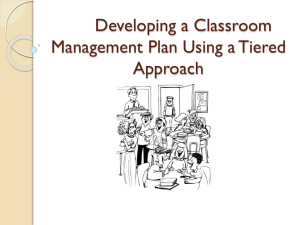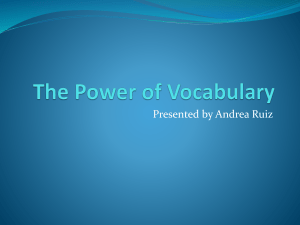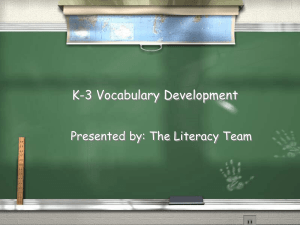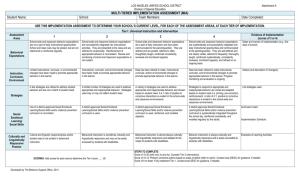Tier 1 Classroom
advertisement
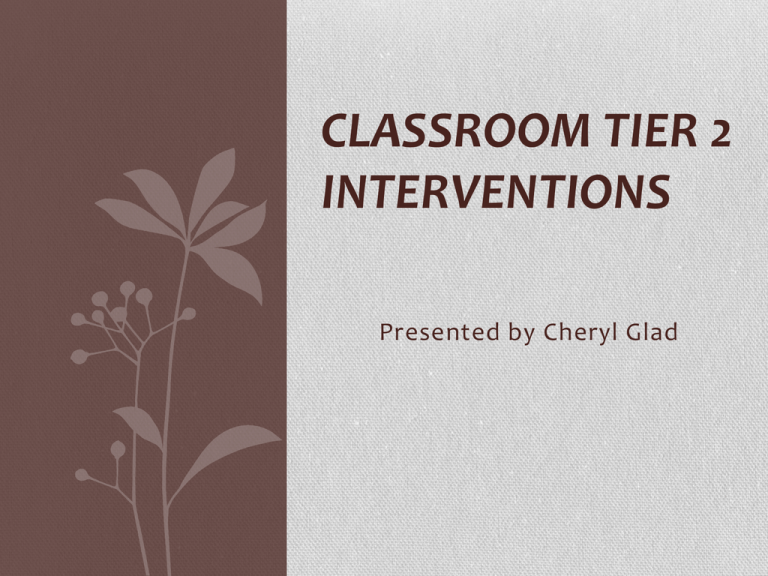
CLASSROOM TIER 2 INTERVENTIONS Presented by Cheryl Glad Pick the Right Tier If many students are making the same mistake Think Green Zone Small groups of students making the same mistake Think Yellow Zone A few students all making different mistakes or A few students with significant behavior problems Think Red Zone Positive pre-intervention conditions (Solid CoreGreen Zone) Focus on prevention Educational approach to behavior Clear 3-5 expectations Expectations are taught, re-taught and reinforced Clear system for dealing with violations Active supervision used in all areas Prerequisite Conditions: Tier 2 Checklist Read each item on the checklist…Think about the classrooms in your school. Is the Tier 1 Process in place? Training Ourselves Training staff to “catch them being good” will be essential to implementing effective support Emphasis on reinforcing expected behavior rather than waiting to punish, reprimand or timeout inappropriate behavior is critical Specific and Contingent Feedback Feedback should be… …contingent: occur immediately following desired behavior …specific: tell learner exactly what they are doing correctly and continue to do in the future “Good job” (not very specific) “I like how you are showing me active listening by having quiet hands and feet and eyes on me” (specific) Group Contingencies Can range from a small group of students… Up to the whole building Contingencies are designed so that peers will encourage positive behavior Group Contingencies Three types: “All for one” (All student’s behavior in the group earns reward for the group) “One for all” (One student’s behavior earns reward for group) “To each his/her own” (Independent groups earn rewards for the group based on member’s behavior) Group Contingencies Class Dojo Rewards: 5 points-1 move on our class game 10 points- 2 moves on our class game 15 points-3 moves on our class game 20 Points-4 moves on our class game 35 points- 5 moves on our class game 40 points-6 moves on our class game 45 points-7 moves on our class game 50 points-8 moves on our class game Novelty is reinforcing… Mystery Motivator Why use a Mystery Motivator Increase anticipation and variety of the selected reinforcers Reduce the opportunities to “deny” or downplay a known, single reinforcer Setting up a Mystery Motivator Prepare a menu of reinforcers using student input and observation Pick one without letting the class know which one Place its name in a sealed envelope Set up the criteria that allows opening the envelope and receiving the reward Generate anticipation and mystery regarding the contents of the envelope At the end of the interval, if the criteria is met, someone opens the envelope and the reward is given out Do Mystery Motivators work with older students? I think they might… A variation on lotteries and raffles The Red Green Show Variant of the behavior lottery Class-wide reinforcement program Reduces peer reinforcement of misbehavior Increases teacher attention on positive behaviors The Red Green Show…Backstage Select tokens and clear container, i.e., game chips, marbles, slips of paper, etc., 2 different colors! Complete reinforcer menu with student input Decide when and how often drawings will be happen Set-up, practice, and rehearse classroom rules/target behaviors The Red Green Show…Opening Night Appropriate behavior earns a green token, which goes in the container Inappropriate behavior earns a red token in the container Draw a token from the container at the end of the time period Reward the group if a green token is chosen, or withhold reinforcement from the group if a red token is drawn Good Behavior Game Basics Two teams Teacher specifies and records misbehaviors Team with fewest misbehaviors wins some reward for the day Data Over 35 published studies IT WORKS! Mostly grades K-8 but some examples in HS and with adults. Yellow Zone Interventions Intervention is continuously available Rapid access to intervention (72 hr) Low effort by teachers Positive system of support Students agree to participate Implemented by all staff/faculty in a school Adequate resources allocated (admin, team) Continuous monitoring for decision making GUIDING QUESTIONS FOR TIER 2 INTERVENTIONS 1. Based on data identify those students who are not meeting social behavior targets What is the specific time period of the data being reviewed? Have you reviewed the best data to tell the story about students in your class? Which data decision rules were used to consider students for Tier 2 support? Do data appear accurate? Do you need to tighten up accuracy of data collection? Is everyone collecting and documenting similar behavioral incidents? Who are the students who have met at least on data decision rule? (List names of students) 2. Discuss and match students with similar problem behaviors (form targeted groups) Which of the 2 common problem behaviors does each student display (minor disruption or noncompliance)? If there is not a perfect match, which is the closest? 3.What function (get/avoid) do the data suggest is associated with student problem behavior? Do students want adult attention (HINT: Teacher redirects and corrections are adult attention too). Do students want peer attention? Do students get a favorite item or activity? Do students avoid doing work? Do students avoid adults? Do students avoid peers? What data support this conclusion? No data? Consider doing a Functional Assessment Checklist for Teachers (Appendix 4. Decide intervention to meet the function of the behavior for the students. What can be done to prevent the disruptive behavior? What skills should be taught first? What can you do to minimize the payoff of the problem behavior? How can you recognize students for displaying the expected behavior? Tier 2 Classroom Support Students with 2 – 5 major ODRs (or repeated minor behaviors) within a year need additional support. Check in/out or Behavior Education Program (BEP) Check and Connect Targeted social skills training Academic Support Peer based tutoring Behavioral contracting The extra supports may be given by any staff member. Typically staff members with some expertise in social and behavioral issues may help with yellow zone supports. These students receive all supports available to all students with universal supports. Check In/Check Out The CICO process will provide systematic performance feedback for students who have been identified as needing Tier 2 support. This intervention is most appropriate for students who seek or enjoy adult attention. This intervention also provides a positive communication link between home and school. The intervention sets students up for success each morning and can be faded to develop student self-management. Check and Connect This intervention is designed to enhance student engagement and foster school completion with academic and social competence. The intervention is implemented by a trained mentor (s). The mentor (s) checks on students daily assessing their engagement with school and learning through close monitoring of their attendance, behavior and grades. The mentor (s) connects with students, offering targeted and/or individualized intervention (based on degree of disengagement) in partnership with school personnel, families, and community service providers. Social Skills Groups Social skills group will provide specific social skills training/instruction, based on the student’s identified function of behavior. Replacement social skill behaviors identified will be taught and practiced. Student performance of skills must be acknowledged by all participating adults. If the school chooses to use a commercial social skills curriculum, it will be important to tie specific skills to the school-wide expectations (e.g. safe, respectful, responsible). Recommended Programs Goldstein: Skillstreaming Goldstein and Glick: Aggression Replacement Training Walker: The Walker Social Skills Curriculum Knoff: Achieve Botvin: Life Skills Training Recommended Programs Rhode:The Tough Kid series Reavis: Best Practices; behavioral and educational strategies for teachers Sprick: Interventions; collaborative planning for students at-risk Guzzo: Second Step (K-8th grade) Academic Supports Remember learning concerns must be ruled out as the cause of inappropriate behavior. Differentiating by content, process and product is part of Tier 1 prevention. Independent work must be at the student’s current level of performance for a student with academic skill deficits to prevent problem behavior. Other considerations… An intervention is something that can be monitored and evaluated for progress and making decisions. A behavior intervention needs to match the function of the behavior. Communication with all participating in the intervention is critical… don’t forget the student! Resources Teacher’s Encyclopedia of Behavior Management The Behavior Management Toolkit Behavioral Response to Intervention NEXT UP- OVERVIEW OF CLASSROOM TIER 3

